
The vision of transforming urban areas into smart cities in India is undeniably ambitious, aiming to leverage technology to enhance the quality of life for citizens. However, it is imperative to recognize that the sustainability and success of smart cities are intricately linked to the development and smart transformation of rural areas. In the context of rural-urban integration, smart villages emerge as a critical component in ensuring the overall effectiveness of the smart city initiative. While urban centers may showcase advanced infrastructure, digital connectivity, and efficient services, the interdependence between rural and urban areas cannot be ignored. Smart villages act as feeder systems, providing the urban landscape with essential resources, including food, skilled labor, and raw materials. Neglecting the development of rural areas can lead to a lopsided growth trajectory, jeopardizing the very foundation of sustainable urbanization. Moreover, an integrated approach fosters a balanced socio-economic ecosystem, preventing the rural-urban divide from deepening. Therefore, a holistic and inclusive strategy that considers the symbiotic relationship between smart cities and smart villages is indispensable for the long-term viability of India’s urbanization efforts. Only through comprehensive rural-urban integration can the nation truly achieve the envisioned synergy between technological advancements and equitable development.
Tag: Urbanization, rural development.
Contents
Decoding:
- In the Introduction, begin by describing Smart city objective, result & need for smart village.
- In Body, elaborate on the reasons why smart cities in India cannot sustain without smart villages.
- Conclude by showing an approach that provides a solution.
Answer:
Smart Cities Mission (SCM) was launched to promote cities that provide core infrastructure and give a decent quality of life to its citizens, a clean and sustainable environment, and application of ‘Smart’ solutions. The smart city project will result in more migration.
Smart Village is a concept adopted by national, state, and local governments of India, as an initiative focused on holistic rural development, derived from Mahatma Gandhi’s vision of Adarsh Gram and Swaraj. Smart Villages are communities in rural areas that use innovative solutions to improve their resilience, building on local strengths and opportunities.
Smart cities in India cannot sustain without smart villages:
- Currently, 31% of India’s population lives in cities; these cities also generate 63% of the nation’s economic activity. These numbers are rapidly increasing, with almost half of India’s population projected to live in its cities by 2030.
- Smart Cities focus on the most pressing needs and on the greatest opportunities to improve the quality of life for residents today and in the future.
- Smart cities are generally focused on subjects like Energy, Transport, Public Health, Education, Affordable Housing, or Waste Management with the help of modern technology.
- Hence if sufficient basic amenities and facilities are not be provided in peri-urban and village areas then an effective resource system of smart cities might not be able to provide a quality of life to people which is the main aim of Smart city mission.
- So, there is a need to build smart villages with better education, health and employment opportunities to make smart cities sustainable.
- Dozens of services including construction, farming, electricity, health care, water, retail, manufacturing, and logistics are needed to build a smart village.
- Computing, communication, and information technologies play a major role in the design, delivery, and monitoring of the services. All the techniques and technologies needed to build a smart village are available now and some of them are being used in villages in India but these are disparate, fragmented, and piecemeal efforts.
But for the success of the smart city mission, rural-urban migration has to be reduced, migration is the major hurdle in the development of smart cities because:
- Migration leads to the development of slums which reduces the availability of basic amenities to the people.
- The large-scale migration led to an increase in labor supply and ultimately reduced wage rate which caused people to live with pitiable housing and education facilities.
- Large epidemics caused by diseases like dengue, malaria, etc are indirect results of population explosion in big cities which is mainly caused by migration.
- It also leads to the degradation of the environment.
According to the 2011 census – Urban distribution: was 68.84% & 31.16%. The level of urbanization increased from 27.81% in the 2001 Census to 31.16% in the 2011 Census. Rapid urbanization and smart city programs can lead to migration to cities, unemployment, and overpopulation in urban areas. So, to develop smart cities, smart villages are a prime need. The government has also taken the ‘Sister cities’ initiative. Gram Sadak Yojana, National Highway Development Programme, Bharatmala, Sethu Bharatam project can increase urban-rural connectivity. Urban-rural integration can help in holistically rejuvenating India.
In case you still have your doubts, contact us on 9811333901.
For UPSC Prelims Resources, Click here
For Daily Updates and Study Material:
Join our Telegram Channel – Edukemy for IAS
- 1. Learn through Videos – here
- 2. Be Exam Ready by Practicing Daily MCQs – here
- 3. Daily Newsletter – Get all your Current Affairs Covered – here
- 4. Mains Answer Writing Practice – here

